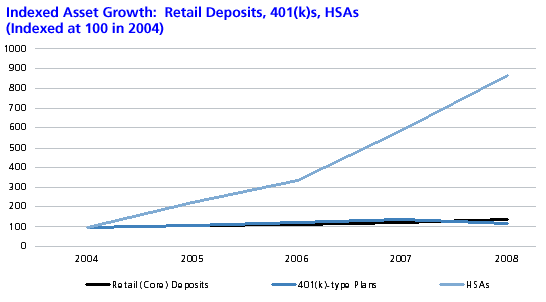HSA Acquisitions: Hare-Like Market, Tortoise-Like Dedication
Abstract
For banks looking to expand their deposit bases during uncertain economic times, HSAs represent a new area for growth. The healthcare market offers a low-cost, low-attriting, “green field” opportunity for banks to build their deposit bases through the acquisition of health savings accounts (HSAs).
HSAs are a dependable source of gradual deposit growth for banks. Celent estimates that over 900,000 new HSAs will be opened in 2009, and that over 3.4 million new accounts will be created in 2012. This is not to mention the roll-overs that can be potentially lured in; roughly 2.5% of all HSAs are estimated to be rolled over annually. HSAs will not propel any bank to the top of the financial services industry (in 2007, HSA assets amounted to only 0.075% of total retail (core) deposits and will continue to be a relatively small component of banks’ asset bases), but banks would be wise to consider HSAs as part of their overall business strategy.
From the bank’s perspective, HSAs fare quite favorably when matched up against retail deposits:
- HSA account acquisition costs are in the $100 - $120 range, whereas in-branch retail deposit account acquistion costs exceed $300.
- Although HSAs have an account closure rate of 12%, retail deposits can have attrition rates of 20%.
- 70-80% of HSA accounts constitute “green field” growth for the acquiring bank, bringing in entirely new customers.
The way HSAs are sold makes them of greater interest to banks. Like 401(k)s and other defined contribution benefit plans, most HSAs are sold via employers. This means that by leveraging non-retail sales channels, banks can register employers into HSA programs. This, in turn, leads to the enrollment of tens, hundreds or even thousands of employees at a time. Thus, HSAs can be acquired at a relatively low cost compared to retail deposit accounts. Successful HSA acquisition is gained through dedication applied to the building and maintenance of channel relationships, including an army of players such as health plans, insurance brokers, benefit administrators and internal sales forces.

"One example of a bank/HSA administrator that is doing an excellent job of supporting its channels is First Horizon Msaver," says Red Gillen, senior analyst with Celent's banking group and author of the report. "Due to market conditions it faced in 2005, Msaver has spent the last four years gradually building an unparalleled base of insurance brokerage alliances, which has been the key to its growth. This approach is one of the main reasons why we focused on Msaver as a case study of HSA acquistion."
Recognizing that brokers serve as “boots on the ground” in terms of health plan (and therefore HSA) sales, Msaver supports its broker alliances through various innovative measures. This strategy appears to be paying off; Msaver’s indexed account growth for 2008 was >1,000, while the overall HSA market had an indexed account growth of 280. Regarding HSA assets, Msaver’s indexed growth for 2008 was again >1,000, while the general HSA market asset growth was indexed at 313 for the same time period.
This report provides a comparative analysis of retail deposit, 401(k) and HSA growth, as well as of the way banks are developing their sales channels. An in-depth case study analysis of First Horizon Msaver’s HSA program also makes up a significant part of the report.

